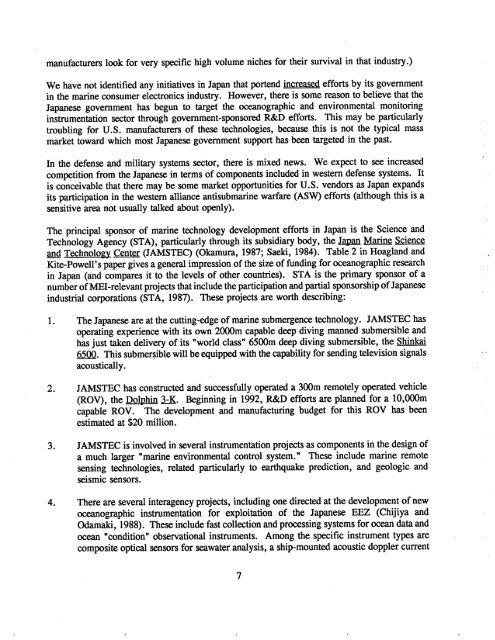WHOI-90-52
WHOI-90-52
WHOI-90-52
Create successful ePaper yourself
Turn your PDF publications into a flip-book with our unique Google optimized e-Paper software.
manufacturers look for very speific high volume niches for their survival in that industry.)<br />
We have not identified any initiatives in Japan that portend increased efforts by its government<br />
in the marne consumer electronics industry. However, there is some reason to believe that the<br />
Japanese government has begun to taget the ocographic and environmenta monitoring<br />
instrmentation setor through government-sponsored R&D efforts. This may be parcularly<br />
troubling for U.S. manufacturers of these<br />
technologies, becuse this is not the typical mass<br />
market toward which most Japanese government support has been tageted in the past.<br />
In the defense and milta systems setor, there is mixed news. We expet to se increased<br />
competition from the Japanese in terms of components included in western defense systems. It<br />
is conceivable that there may be some market opportunities for U.S. vendors as Japan expands<br />
its parcipation in the western alliance antisubmarne warare (ASW) efforts (although this is a<br />
sensitive area not usually taked about openly).<br />
The principal sponsor of marne technology development efforts in Japan is the Science and<br />
Technology Agency (STA), parcularly through its subsidiar body, the Japan Marine Science<br />
and Technology Center (JAMSTEC) (Okamura, 1987; Saeki, 1984). Table 2 in Hoagland and<br />
Kite-Powell's paper gives a general impression of the size of funding for ocographic resech<br />
in Japan (and compares it to the levels of other countres). STA is the primar sponsor of a<br />
number ofMEI-relevant projects that include the parcipation and paral sponsorship of Japanese<br />
industral corprations (STA, 1987). These projects are wort describing:<br />
1. The Japanese are at the cutting-edge of marne submergence technology. JAMSTEC has<br />
operating experience with its own 200m capable deep diving manned submersible and<br />
has just taen delivery of its "world class" 6500m deep diving submersible, the Shinka<br />
6500. This submersible wil be equippe with the capabilty for sending television signals<br />
acousticaly.<br />
2. JAMSTEC has constrcted and successfully operate a 300m remotely operate vehicle<br />
(ROV), the Dolphin 3-K. Beginning in 1992, R&D efforts are planned for a 10,OOm<br />
capable ROV. The development and manufacturig budget for this ROV has been<br />
estimated at $20 milion.<br />
3. JAMSTEC is involved in several instrmentation projects as components in the design of<br />
a much larger "marne environmenta control system." These include marne remote<br />
sensing tehnologies, relate parcularly to eaquake prediction, and geologic and<br />
seismic sensors.<br />
4. There are several interagency projects, including one directed at the development of new<br />
ocographic instrumentation for exploitation of the Japanese EEZ (Chijiya and<br />
Odamak, 1988). These include fast collection and procssing systems for oc data and<br />
oc "condition" observational instruments. Among the speific instrument typs are<br />
composite optica sensors for sewater analysis, a ship-mounted acoustic doppler current<br />
7
















